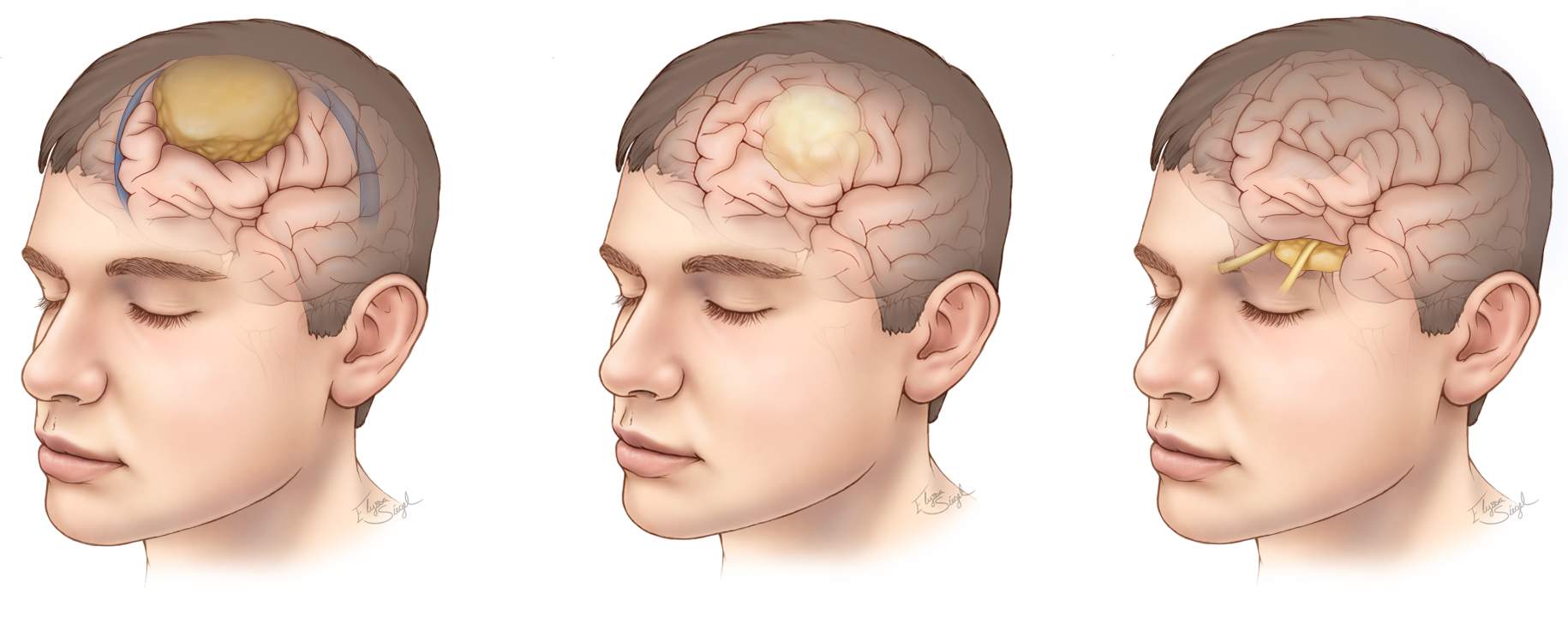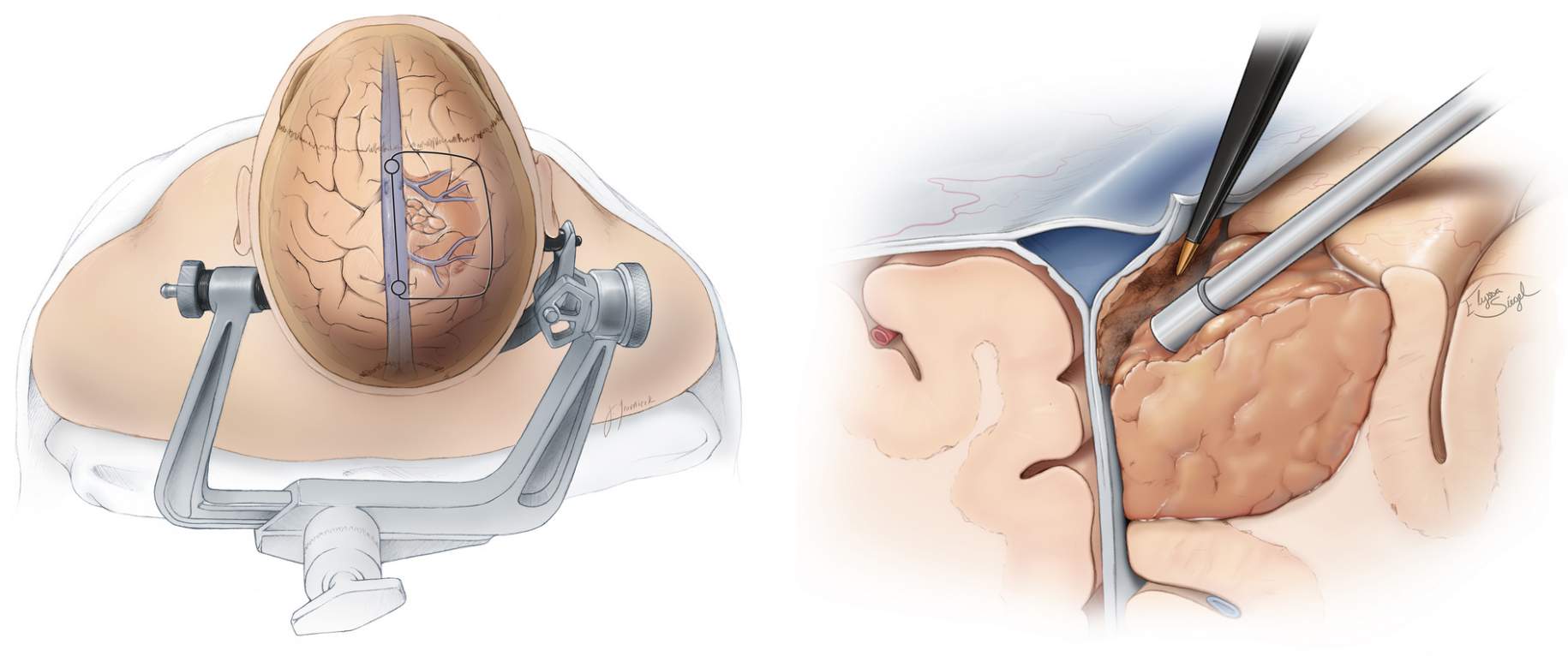Overview of Brain Tumor


Overview
A brain tumor is a mass of abnormal cells located within the brain. Most brain tumors are benign and slow growing, but some are malignant and fast growing. General symptoms include new-onset headaches, nausea and vomiting, confusion, fatigue, personality changes, and seizures.
The recovery outlook for each patient varies depending on the type of tumor and its size at diagnosis, location, and growth rate. However, advances in surgical techniques and technologies have greatly improved patient survival and outcomes.
What Is a Brain Tumor?
A brain tumor is a mass of abnormal cells within the brain. Brain tumors can arise from tissues within the brain (primary brain tumor) or from a cancer located elsewhere in the body (secondary or metastatic brain tumor). Benign brain tumors typically grow slowly and stay within the brain without invading surrounding tissues. In contrast, malignant brain tumors can grow quickly and spread to other body parts through a process called metastasis.

Figure 1: Different types of brain tumors. Meningioma (left), glioma (center), and pituitary tumor (right) are among the most common brain tumor types.
There are many types of brain tumors. Each type can differ in growth rate, typical location, size at the time of diagnosis, and who they affect. Brain tumors are the most common type of tumor in children, and the second or third most common type in young adults (breast cancer is highest in females). Some brain tumor types affect males more often than females, or vice versa. The following are a few of the more common brain tumors and the percentage of the tumor count among all brain and other central nervous system (CNS) tumors.
Meningioma (38%)—arises from the membranous covering of the brain (meninges). Most are benign and grow slowly inward from the meninges to push on the brain and surrounding structures.
Glioma (25%)—arises from glial cells that surround and support the neurons of the CNS. Tumors in this category are further classified according to the type of glial cell from which they originate (astrocytoma, glioblastoma multiforme, ependymoma, oligodendroglioma, mixed glioma). Although some types are relatively benign, gliomas comprise 80% of malignant brain or other CNS tumors.
Pituitary tumor (17%)—arises from the pituitary gland at the base of the brain. The pituitary gland is important for normal hormone release. Most pituitary tumors are benign. However, large tumors can compress nearby nerves and tissues, causing vision defects and hormone abnormalities.
Other brain tumor types include acoustic neuroma, craniopharyngioma, chordoma, chondrosarcoma, or brain metastases. Most brain metastases arise from cancers in the lung, breast, colon and rectum, skin (melanoma), and kidneys (renal cell carcinoma). In adults, brain metastases are more common than primary brain tumors.
Why should you have your surgery with Dr. Cohen?
Dr. Cohen
- 7,500+ specialized surgeries performed by your chosen surgeon
- More personalized care
- Extensive experience = higher success rate and quicker recovery times
Major Health Centers
- No control over choosing the surgeon caring for you
- One-size-fits-all care
- Less specialization
For more reasons, please click here.
What Are the Symptoms?
Signs and symptoms of a brain tumor depend on the type of brain tumor and its location, size, and growth rate. Slow-growing tumors might not be detected until they are large at the time of diagnosis. These tumors can compress surrounding nerves and lead to symptoms. Tumors that arise in locations critical for specific functions such as speech, hearing, vision, sensation, and movement will lead to corresponding deficits.
General signs and symptoms include new-onset headaches, nausea and vomiting, fatigue, confusion, personality changes, problems with balance, and seizures. Patients with brain tumors might experience issues with vision or hearing, loss of sensation or movement in the arms or legs, and difficulties with speech or decision making.
What Are the Causes?
Brain tumors, like tumors in general, are caused by the growth of abnormal cells that continue to divide when they are not supposed to. Normally, cell division is tightly controlled by a set of instructions in the DNA. However, if certain sections within the DNA are changed (mutated), the cells become abnormal and continue dividing to form a mass of cells called a tumor. Large amounts of radiation from X-rays can increase the risk of developing a brain tumor. Certain inherited disorders such as neurofibromatosis 1 (NF1), neurofibromatosis 2 (NF2), and von Hippel-Lindau disease (VHL) are prone to cause the development of benign CNS tumors.
How Common Is It?
Approximately 24 new cases of brain tumor are diagnosed for every 100,000 people. Although brain and other tumors of the CNS are the most common tumor type in children aged 0 to 14 years, the frequency of brain tumor diagnoses generally increases with age. Most brain tumors are benign and slow growing.
How Is It Diagnosed?
Brain tumors are usually diagnosed by magnetic resonance imaging (MRI). For this test, the patient will lie still in a large cylindrical magnet for 45 minutes to 1 hour. A contrast dye might be given to highlight the tumor within the brain. Other tests such as computed tomography (CT) and positron emission tomography (PET) might be used to obtain additional information about the tumor or surrounding tissues. CT scans are better than MRI for examining abnormalities in bony structures such as the skull. PET scans can gauge tumor activity, brain function, and blood flow.
If a tumor is found, a biopsy might be performed to collect a small sample of the tumor for testing and identification. A section of the tumor is examined by a pathologist under a microscope to determine the type of cells making up the tumor and how aggressive the tumor is.

Figure 2: MRI (left) and CT imaging (right) of 2 different patients with a meningioma. MRI offers better detail of soft tissues in the brain, whereas CT imaging is preferred for assessing bony structures.
What Are the Treatment Options?
Brain tumors are treated primarily with surgery and radiotherapy. If the tumor is incidentally found and does not produce symptoms, the best course of treatment varies depending on the nature of the tumor involved and the patient’s age, health, and preference.
Observation
Patients with no symptoms but are incidentally diagnosed might be observed over time. Slow-growing tumors such as meningiomas and schwannomas might be followed with regular imaging, especially in older patients. However, the best approach must be tailored to each patient.
Surgery
Surgery is usually indicated if the tumor produces symptoms. The goal is to remove as much tumor as possible without damaging the brain and normal function. Tumors that have spread to nearby brain tissues are typically not cured by surgery. However, surgery is often done initially to reduce the amount of tumor for later radiation or chemotherapy. After surgery, the patient is observed in the intensive care unit overnight. Depending on the complexity of the surgery, patients might stay for a few days or longer in the hospital.

Figure 3: The patient’s head is stabilized (left), and the surgeon gently removes tumor from the dura (right).
Surgery involves stabilizing the patient’s head with a skull clamp, performing a craniotomy, making a cut through the outermost layer of the meninges (dura), and then carefully removing the tumor from the brain. The exact surgical approach depends on the location and size of the tumor. Although the goal for most surgeries is to remove as much tumor as possible, a surgeon might choose to leave some tumor behind to avoid damaging nearby blood vessels and nerves. Radiation would then be used to treat the remaining tumor.
Depending on the type of tumor, the amount of blood vessels involved, and the extent to which the tumor has spread to nearby tissues, tumor removal during surgery can be associated with complications. General complications include brain swelling (edema), cerebrospinal fluid leak, bleeding, infection, and rarely stroke.
In this video, Dr. Cohen describes the surgical techniques for treating a patient with brainstem astrocytoma.
For more information about the technical aspects of the surgery and extensive experience of Dr. Cohen, please refer to the chapter on Principles of Brainstem Surgery in the Neurosurgical Atlas.
In this video, Dr. Cohen describes the surgical techniques used to resect a patient's pituitary microadenoma.
For more information about the technical aspects of the surgery and extensive experience of Dr. Cohen, please refer to the chapter on Pituitary Microadenoma in the Neurosurgical Atlas.
Radiation
Radiation is another option for treating brain tumors and can be used in combination with surgery when a tumor cannot be removed completely. There are multiple ways to deliver this treatment; radiosurgery and fractionated radiotherapy are among the more common options.
In radiosurgery, hundreds of small, concentrated beams of radiation are aimed at the tumor using 1 of the 3 radiosurgical devices, the Gamma Knife, Cyber Knife, or Novalis. The procedure itself takes 30 to 50 minutes, and the patient is placed in a stereotactic headframe on the day of the procedure, which stabilizes the patient’s head and enables the treatment team to calibrate the machine to the patient’s head and tumor.
Patients who undergo fractionated radiotherapy receive smaller doses of radiation over several visits. Each visit takes only 5 to 15 minutes, and the patient can go about their business before and after the visit.
It is important to note that radiation therapy does not remove the tumor. It can, in some cases, cause the tumor to shrink. The main goal of radiation is to stop the growth of the tumor. As a result, the patient must return for MRI scans on a yearly basis (or more often) to check for any new growth.
Possible complications of radiation therapy include headaches, seizures, neurologic problems depending on the area being treated, and difficulties with thinking or decision making. Possible injury of healthy tissues caused by radiation (radiation necrosis) is another possible but delayed complication of radiotherapy that results in headaches, memory loss, personality changes, and seizures. This complication is rare but can occur months to years after treatment.
What Is the Recovery Outlook?
The outcome for patients with a brain tumor depends on the type of tumor, how involved the tumor is with the brain, extent of spread to nearby tissues, and the severity of symptoms before treatment. Advances in surgical techniques and technologies have improved the safety and efficacy of brain tumor treatments. Patients should discuss what to expect after treatment with their physician.











